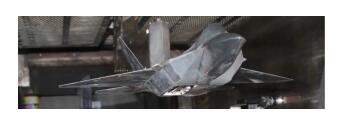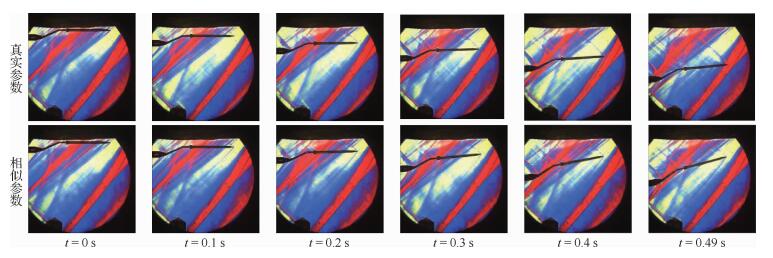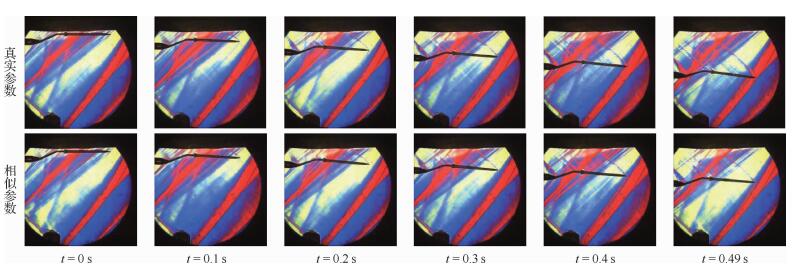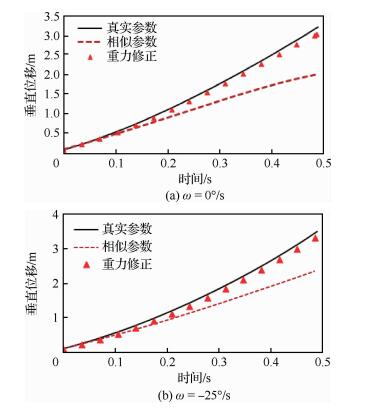新一代战机采用内埋弹舱技术,增强战机的隐身性能以及减少战机超声速阻力。在超声速飞行时,存在较强的激波/剪切层干扰流动,使机弹相容性问题变得较复杂,载弹在投放的过程中会受到复杂的气动干扰,影响分离安全性[1-6]。
国内外对机弹分离问题进行了大量的地面模拟研究,研究手段包括数值模拟和风洞试验[7-12]。捕获轨迹(Captive Trajectory System, CTS)风洞试验技术和风洞模型投放试验技术是对超声速机弹分离安全性预测与评估的常用技术[13-17]。文献[14]详细论述了两种技术的优缺点对比,CTS为一种准定常的试验手段,能够实现各种分离参数下分离特性的模拟,能够按照机弹分离时真实运动学参数以及动力学参数进行模拟,获得与全尺寸飞行试验数据基本一致的试验结果。但是存在支撑干扰以及机构对流场的干扰效应,另外受制于分离机构,载弹分离时所能模拟的位姿运动空间有限。风洞模型投放试验技术为同时保证模型几何相似以及动力学相似条件[15-17],在风洞中释放模型自由度,使用弹射装置模拟初始分离特性,使用高速相机记录导弹的分离特性。载弹位姿运动空间不受机构的限制。
低速风洞模型投放试验中除了保证模型几何相似外,主要的相似参数是弗鲁德数Fr[18-20],超声速时动力学相似准则实现较低速复杂,需要保证来流马赫数Ma相似模拟,试验模型与实物要几何相似,再根据动力相似准则得到模型惯量、质量以及初始弹射参数。目前常用的方法有重模型法与轻模型法,超声速风洞模型缩比较大,重模型法实现比较困难,而轻模型法较易实现[17]。采用轻模型法相似参数时,模型的重力与气动力之比与实物不一致,导致模型垂直加速度不足,造成其垂直位移与实物有差别。
针对超声速风洞模型投放试验轻模型法相似参数中垂直加速度不足带来的问题进行研究,采用CTS试验技术对真实参数和轻模型法动力学相似参数条件下机弹分离特性进行对比研究,分析重力效应对机弹分离试验结果的影响。
1 试验方法与设备 1.1 试验方法CTS试验技术具有易于改变试验参数的优势,可以模拟导弹全尺寸真实参数条件,所以选用CTS技术对全尺寸真实参数与轻模型法相似参数两种条件进行试验研究。
投放试验中动力学相似准则[21]要求模型受到气动力与模型重力之比相似,可表达为
| $ {\left( {\frac{Y}{{mg}}} \right)_{\rm{m}}} = {\left( {\frac{Y}{{mg}}} \right)_{\rm{s}}} $ | (1) |
式中:Y为气动力; m为质量; g为重力加速度;下标“m”代表模型,下标“s”代表飞行器。
式(1)展开可得
| $ {\left( {\frac{{\frac{1}{2}{\rho _{\rm{m}}}M{a^2}\gamma R{T_{\rm{m}}}C{S_{\rm{r}}}}}{{{\rho _{{\rm{mm}}}}{V_{\rm{m}}}g}}} \right)_{\rm{m}}} = {\left( {\frac{{\frac{1}{2}{\rho _{\rm{s}}}M{a^2}\gamma R{T_{\rm{s}}}C{S_{\rm{r}}}}}{{{\rho _{{\rm{ss}}}}{V_{\rm{s}}}g}}} \right)_{\rm{s}}} $ | (2) |
式中:ρm为风洞气体密度;ρs为真实飞行气体密度;Ma为马赫数;γ为气体比热比;R为气体常数;T为静温;C为气动力系数,Sr为参考面积;ρmm为试验模型密度;Vm为试验模型体积;ρss为真实飞行器密度;Vs为真实飞行器体积。
试验模型几何缩比为特征长度比定义为
| $ \frac{{{k_\rho }{T_{\rm{m}}}}}{{{k_1}{\rho _{{\rm{mm}}}}{g_{\rm{m}}}}} = \frac{{{T_{\rm{s}}}}}{{{\rho _{{\rm{ss}}}}{g_{\rm{s}}}}} $ |
轻模型法相似准则中采用假设:
| $ \left\{ \begin{array}{l} {\rho _{{\rm{mm}}}} = {k_\rho }{\rho _{{\rm{ss}}}}\\ {g_{\rm{m}}} = \frac{1}{{{k_1}}} \cdot \frac{{{T_{\rm{m}}}}}{{{T_{\rm{s}}}}}{g_{\rm{s}}} \end{array} \right. $ | (3) |
一般情况下,真实气流静温与模型试验时静温差别不大,而高速风洞试验中模型几何缩比较大,所以,要保证模型与实物重心运动的轨迹相似,模型的垂直加速度应比实物大得多,这给高速投放试验的模拟带来了很大的困难。轻模型法投放试验中一般近似处理为ggm=gs=g,轻模型法除了重力加速度外,全部运动都是严格相似的,它使模型有正确的弹射运动和俯仰摆动。
虚拟重力修正方法[22]是试验后对结果中的纵向下落位移进行修正,补偿重力加速度不足导致的下落位移量。修正后投放物模型位移为
| $ Z' = Z + \Delta Z $ | (4) |
式中:Z为轻模型法试验参数下载弹下落位移;ΔZ为虚拟重力修正位移。
根据式(3)可知,轻模型法重力加速度理论应为
| $ \Delta Z = \frac{1}{2}\left( {\frac{{{T_{\rm{m}}}}}{{{T_{\rm{s}}}{k_1}}} - 1} \right)g{t^2} $ | (5) |
试验是在中国航天空气动力技术研究院的FD-12风洞中使用CTS试验系统开展的,风洞试验段横截面尺寸为1.2 m×1.2 m。CTS试验系统六自由度机构采用并联机构的构型形式,如图 1所示,与串联六自由度机构相比,具有定位精准度高、机构刚度高以及动态性能好等特点。CTS试验系统定位精度:位置定位精度 < 0.1 mm,姿态定位精度 < 0.05°。

|
| 图 1 FD-12风洞CTS试验系统 Fig. 1 CTS test system in FD-12 wind tunnel |
试验载机模型采用类F-22飞机外形的气动布局,如图 2所示,采用内埋弹舱,试验挂位为内埋弹舱靠近机身内侧挂位。载弹模型采用旋成体弹身加四片尾翼的标准模型布局形式,如图 3所示。载弹质量m=190 kg,转动惯量Ixx=1.2 kg·m2、Iyy=180 kg·m2、Izz=180 kg·m2。

|
| 图 2 试验载机模型 Fig. 2 Test aircraft modelFigure options |

|
| 图 3 试验载弹模型 Fig. 3 Test missile modelFigure options |
试验模型几何缩比为1:20。试验模拟马赫数Ma=1.5,模拟高度15 km。真实参数按照载弹实际尺寸以及飞行高度得到,相似参数由真实参数按照轻模型法动力学相似转换得到。试验结果中载弹的位姿参考坐标原点为载弹初始投放位置。数据中时间序列和载弹相对载机下落位移均按全尺寸飞行状态处理。
2.2 真实参数下试验结果分析图 4是真实参数下不同弹射角速度载弹下落位移以及俯仰角对比曲线,可以看出弹射角速度对载弹俯仰角有较大影响,弹射角速度ω为-25 °/s时载弹在0.5 s时间内一直低头运动,角速度为零时载弹在载机流场的干扰下出现了“抬头”的运动;载弹下落位移受载弹质量、弹射线速度以及载弹在载机干扰流场中的升力等因素影响。图 5是载弹在下落过程中升力系数的变化曲线,由于两种弹射角速度下载弹俯仰角差别较大,导致载弹在下落过程中受到的升力差别较大。在相同的载弹质量和弹射线速度条件下载弹在0.25 s之前下落位移基本重合,随着升力差异的影响逐渐积累,在0.25 s之后下落位移开始出现“分叉”。可以看出:弹射角速度影响载弹俯仰角的变化,而俯仰角不同导致了载弹升力差异,升力差别导致了载弹的下落位移“分叉”。

|
| 图 4 不同分离角速度载弹位姿对比 Fig. 4 Comparisons of missile pose at different separating angular speedsFigure options |

|
| 图 5 下落过程中载弹升力对比 Fig. 5 Comparisons of missile lift in descending processFigure options |
图 6是弹射角速度为0、分离初速度V=3.8 m/s时,全尺寸真实参数与轻模型法相似参数条件下,利用CTS试验技术得到的载弹下落的位姿对比曲线,图 7是试验过程中对应载弹下落时间的纹影照片,图 8和图 9是弹射角速度-25 °/s时载弹位姿对比曲线和纹影照片结果。从试验结果中可以看出采用轻模型法得到的相似参数,由于重力加速度模拟不足,载弹垂直下落较慢,纹影结果显示载弹靠近载机时受到流场的干扰效应较强,所以重力加速度模拟不足时,不仅影响垂直位移的结果,而且由于载弹下移慢,会引起载弹姿态角变化更剧烈。初始弹角速度为0时,采用轻模型法相似参数俯仰角结果显示载弹快速“抬头”,会出现载弹不安全的分离特性,真实参数下载弹抬头速度较为缓慢,在导弹下落3.5 m时抬头角度为4°,载弹可以安全分离。初始角速度为-25 °/s时,真实参数下载弹俯仰角持续低头,可以判断载弹能安全分离,而采用轻模型法相似参数得到的结果显示:俯仰角在0.25 s之后开始出现“抬头”的趋势。

|
| 图 6 不同参数下载弹下落位姿对比(ω=0 °/s, V=3.8 m/s) Fig. 6 Comparisons of missile pose for different parameters in descending process (ω=0 °/s, V=3.8 m/s)Figure options |

|
| 图 7 不同参数下载弹下落纹影(ω=0 °/s, V=3.8 m/s) Fig. 7 Schlieren results of missile for different parameters in descending process (ω=0 °/s, V=3.8 m/s)Figure options |

|
| 图 8 不同参数下载弹下落位姿对比(ω=-25 °/s, V=3.8 m/s) Fig. 8 Comparisons of missile pose for different parameters in descending process (ω=-25 °/s, V=3.8 m/s)Figure options |

|
| 图 9 不同参数下载弹下落纹影(ω=-25 °/s,V=3.8 m/s) Fig. 9 Schlieren results of missile for different parameters in descending procedure (ω=-25 °/s, V=3.8 m/s)Figure options |
由于试验状态中模型挂位一侧是弹舱内安装的导弹,另一侧是弹舱边沿,两侧受到载机干扰流场不对称,所以导致在导弹下落过程中出现偏航角姿态不对称,而且轻模型法相似参数状态下偏航角变化更剧烈。
2.4 虚拟重力修正结果对比分析采用对试验结果补偿虚拟重力的修正方法,对轻模型法得到的载弹下落垂直位移进行修正,图 10是修正前后下落位移的对比曲线,结果表明,修正后下落位移接近真实参数下的试验结果,由于载弹在下落过程中位移和姿态是通过载弹受到的干扰气动力和气动力矩相互耦合作用的,该方法不能修正由于载弹下落快慢导致的弹体姿态的差异,而姿态角差异又带来载弹气动力的差异,所以虚拟重力修正后结果与真实参数下垂直位移存在差量。

|
| 图 10 虚拟重力修正前后下落位移的对比 Fig. 10 Comparison of descending displacement with or without virtual gravity correctionFigure options |
由2.3节可以看出:轻模型法由于重力效应模拟不足导致载弹下落较慢,脱离载机流场干扰区更慢,而试验中载弹受到载机干扰效应是增加了载弹正俯仰力矩,出现“抬头”迎角,所以使载弹升力增加,升力增量对下落位移的影响使下落位移偏小。
3 结论1) 采用轻模型法得到的试验结果由于重力模拟不足导致载弹垂直下落位移较实际真实参数慢,采用虚拟重力修正后,两者下落位移曲线接近,由于存在弹体姿态角耦合干扰的问题,虚拟重力修正方法不能完全修正下落位移。
2) 轻模型法相似参数条件下载弹下落较慢,载机对载弹的气动干扰更为强烈,导致载弹姿态角变化更加剧烈。
3) 采用轻模型法相似参数得到的机弹相容性结果偏危险。
| [1] |
吴继飞, 罗新福, 徐来武, 等. 内埋武器分离特性及其改进方法研究[J]. 空气动力学学报, 2014, 32(6): 814-819. WU J F, LUO X F, XU L W, et al. Investigation on internal weapon separation characteristics and flow control methods[J]. Acta Aerodynamica Sinica, 2014, 32(6): 814-819. (in Chinese) |
| Cited By in Cnki (7) | Click to display the text | |
| [2] |
张俊祥, 冯金富, 于心一, 等. 一种改善内埋式弹舱气流特性的方法[J]. 弹箭与制导学报, 2011, 31(6): 165-168. ZHANG J X, FENG J F, YU X Y, et al. A new method for improving cavity flow[J]. Journal of Projectiles, Rockets, Missiles and Guidance, 2011, 31(6): 165-168. (in Chinese) |
| Cited By in Cnki (4) | Click to display the text | |
| [3] |
史爱明, 叶正寅, 杨永年. 内埋式弹舱舱门气动载荷计算分析研究[J]. 航空计算技术, 2007, 37(3): 5-6. SHI A M, YE Z Y, YANG Y N. Calculation and analysis for aerodynamic loads acting on interior weapon cabin's door[J]. Aeronautical Computing Technique, 2007, 37(3): 5-6. (in Chinese) |
| Cited By in Cnki (22) | Click to display the text | |
| [4] | SRINIVASAN A. Analysis of unsteady bay shear layer effects on store separation characteristics: AIAA-2009-0546[R]. Reston: AIAA, 2009. |
| Click to display the text | |
| [5] | HAIGERMOSER C, VESELY L, NOVARA M, et al. Time-resolved PIV applied to cavity unsteady flows: AIAA-2007-3432[R]. Reston: AIAA, 2007. |
| Click to display the text | |
| [6] | STEVEN J B, JUSTIN L W, BRIAN O M P. Particle image velocimetry of a three-dimensional supersonic cavity flow: AIAA-2012-0030[R]. Reston: AIAA, 2012. |
| [7] |
杨俊, 李骞, 谢云恺, 等. 超声速内埋武器分离数值研究[J]. 弹箭与制导学报, 2018, 35(4): 171-174. YANG J, LI Q, XIE Y K, et al. Numerical studies on store separation from a weapon bay at supersonic speed[J]. Journal of Projectiles, Rockets, Missiles and Guidance, 2018, 35(4): 171-174. (in Chinese) |
| Cited By in Cnki (7) | Click to display the text | |
| [8] | STEPHEN R, PERILLO. Challenges and emerging trends in store separation engineering air force seek eagle office perspective: AIAA-2009-0101[R]. Reston: AIAA, 2009. |
| Click to display the text | |
| [9] | ROBERT L, STALLINGS J R. Store separation from cavities at supersonic flight speeds[J]. Spacecraft, 1983, 20(2): 129-132. |
| Click to display the text | |
| [10] | JOHNSON R A. Store separation trajectory deviations due to unsteady weapons bay aerodynamics: AIAA-2008-0188[R]. Reston: AIAA, 2008. |
| Click to display the text | |
| [11] | SHIPMAN J, ARUNAJATESAN S, CAVALLO P A, et al. Flow control for enhanced store separation: AIAA-2007-1239[R]. Reston: AIAA, 2007. |
| Click to display the text | |
| [12] |
唐上钦, 黄长强, 翁兴伟. 考虑气动干扰的导弹内埋式发射弹道研究[J]. 弹箭与制导学报, 2013, 33(3): 138-142. TANG S Q, HUANG C Q, WENG X W. The study on trajectory of missile separating from cavity with aerodynamic interference considered journal of projectiles[J]. Journal of Projectiles, Rockets, Missiles and Guidance, 2013, 33(3): 138-142. (in Chinese) |
| Cited By in Cnki (10) | Click to display the text | |
| [13] |
薛飞, 金鑫, 王誉超, 等. 内埋武器高速投放风洞试验技术[J]. 航空学报, 2017, 38(1): 120114. XUE F, JIN X, WANG Y C, et al. Wind tunnel test technique on high speed weapon delivery from internal weapons bay[J]. Acta Aeronautica et Astronautica Sinica, 2017, 38(1): 120114. (in Chinese) |
| Cited By in Cnki (9) | Click to display the text | |
| [14] |
李周复. 风洞特种试验技术[M]. 北京: 航空工业出版社, 2010: 88-161. LI Z F. Wind tunnel special tests technique[M]. Beijing: Aviation Industry Press, 2010: 88-161. (in Chinese) |
| [15] | REED J F. A comparison between transonic wind-tunnel and full-scale store separation characteristics[J]. Engineering Notes, 1969, 6(3): 281-283. |
| Click to display the text | |
| [16] | VEAZEY D. Current AEDC weapons separation testing and analysis to support flight testing: AIAA-2004-6847[R]. Reston: AIAA, 2004. |
| Click to display the text | |
| [17] |
蒋增辉, 宋威, 鲁伟, 等. 高速风洞投放模型试验技术的关键问题及应用领域[J]. 空气动力学学报, 2016, 34(6): 744-749, 802. JIANG Z H, SONG W, LU W, et al. Critical problems and applied fields of drop-model testing technique in high speed wind tunnel[J]. Acta Aerodynamica Sinica, 2016, 34(6): 744-749, 802. (in Chinese) |
| Cited By in Cnki (7) | Click to display the text | |
| [18] |
蒋增辉, 宋威, 贾区耀, 等. 多体分离风洞自由飞试验[J]. 空气动力学学报, 2016, 34(5): 581-586. JIANG Z H, SONG W, JIA Q Y, et al. Wind tunnel free-flight test for multi-bodies separation[J]. Acta Aerodynamica Sinica, 2016, 34(5): 581-586. (in Chinese) |
| Cited By in Cnki (4) | Click to display the text | |
| [19] |
张召明. 飞机外挂物投放低速风洞试验技术研究[J]. 南京航空航天大学学报, 2003, 35(3): 318-321. ZHANG Z M. Experimental research of jettison of aircraft external store in low speed wind tunnel[J]. Journal of Nanjing University of Aeronautics & Astronautics, 2003, 35(3): 318-321. (in Chinese) |
| Cited By in Cnki (18) | Click to display the text | |
| [20] |
蔡国华. 载机投放外挂物低速风洞模拟技术[J]. 空气动力学学报, 1999, 17(4): 477-483. CAI G H. Research of experimental techniques about dropping test of external stores in the low speed wind tunnel[J]. Acta Aerodynamica Sinica, 1999, 17(4): 477-483. (in Chinese) |
| Cited By in Cnki (8) | Click to display the text | |
| [21] |
恽起麟. 风洞试验[M]. 北京: 国防工业出版社, 2000: 555-568. YUN Q L. Wind tunnel testing[M]. Beijing: National Defense Industry Press, 2000: 555-568. (in Chinese) |
| [22] |
宋威, 鲁伟, 蒋增辉, 等. 内埋武器高速风洞弹射投放模型试验关键技术研究[J]. 力学学报, 2018, 50(6): 1346-1355. SONG W, LU W, JIANG Z H, et al. The crucial technique investigation of wind-tunnel drop-model testing for the supersonic internal weapons[J]. Chinese Journal of Theoretical and Applied Mechanic, 2018, 50(6): 1346-1355. (in Chinese) |
| Cited By in Cnki (2) | Click to display the text |



